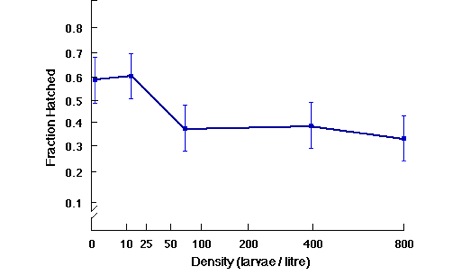Egg Hatch Inhibition
Larva-induced egg hatch inhibition
Eggs within the genera Ochlerotatus and Aedes are capable of refraining from hatching when their environment is crowded with large larvae. We have shown this in laboratory situations (below, Livdahl et al. 1984) and field experiments (below, Livdahl and Edgerly 1987) with O. triseriatus. We also have laboratory evidence that this phenomenon occurs in A. albopictus and A. aeqypti, and that larvae inhibit eggs interspecifically with differential intensities and egg sensitivities (Edgerly et al. 1993).

Hatch rates of Ochlerotatus triseriatus eggs immersed in treeholes that had been stocked with fixed densities of O. triseriatuslarvae in August, 1986, pooled across four immersion periods (2, 4, 8, 16 d). There were no significant differences for diffent time intervals, probably because the eggs quickly entered diapause.
This novel interspecies interaction may have implications for the invasion of North America by A. albopictus, which showed the lowest sensitivity to high densities of larvae as well as the most inhibitory larvae. The mechanism of this inhibition is thought to be grazing of microbes from egg surfaces by larvae, which may remove the source of oxygen depletion that is necessary to stimulate egg hatch (right, Edgerly and Marvier 1991). Inhibition of egg hatching may provide a mechanism for the unhatched egg to choose a time for hatching that minimizes potential competition with larger larvae, as well as possible cannibalism by larger larvae.